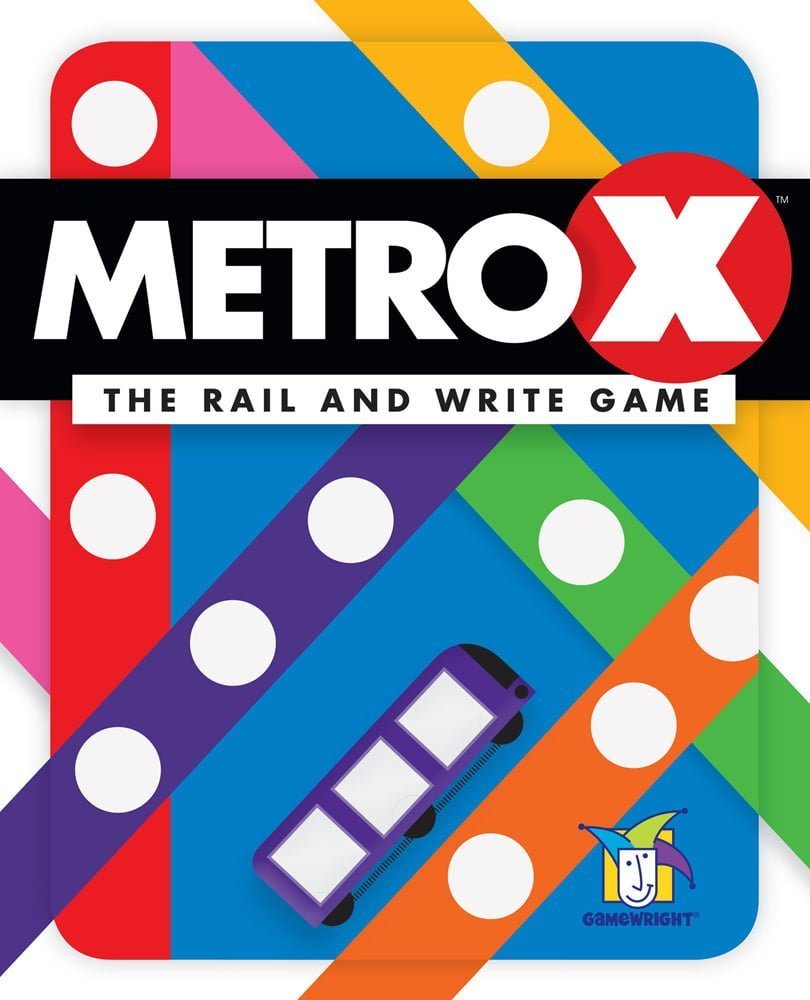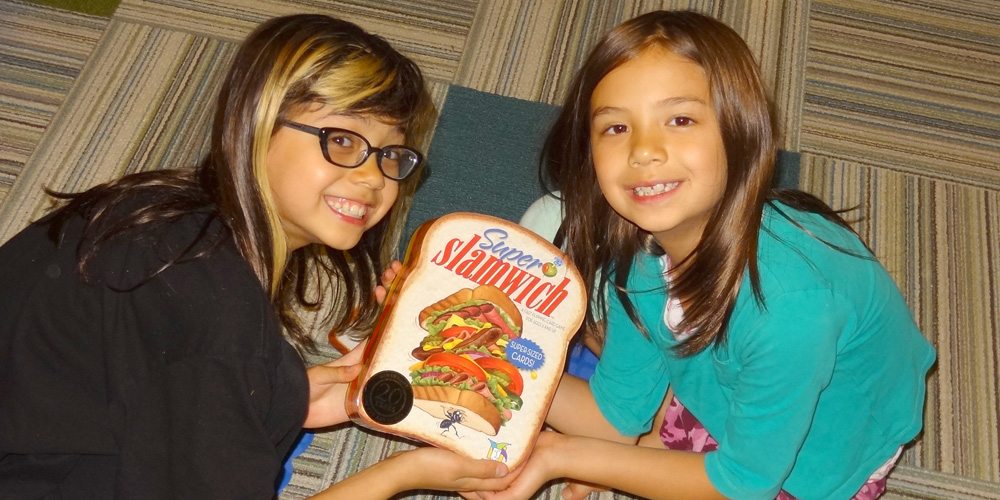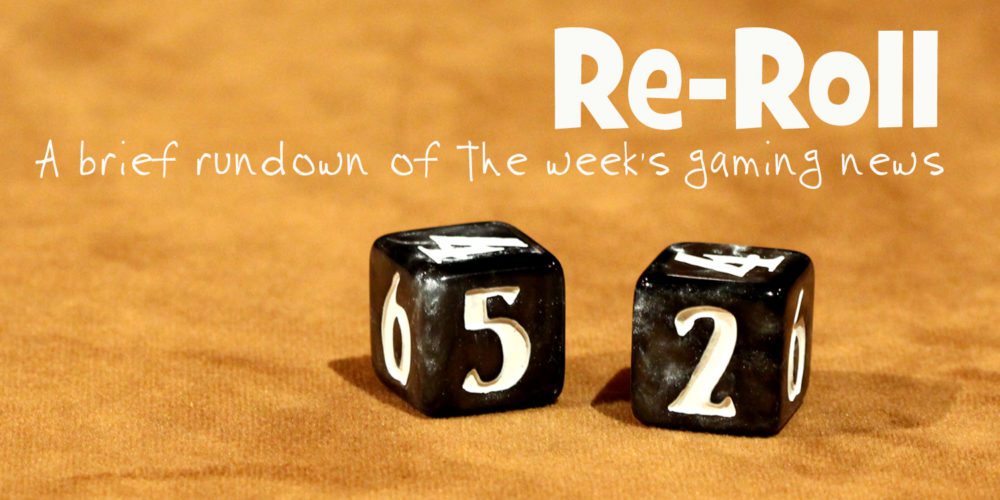Build your subway stations, set up transfer stations, and complete your tracks to score points in Metro X: The Rail and Write Game.
What Is Metro X?
Metro X is a flip-and-fill game for 1 to 6 players, ages 8 and up, and takes about 20 minutes to play. It was designed by Hisashi Hayashi, and is published in the US by Gamewright, with a retail price of about $15. (It was originally published in Japan by Okazu Brand under the title MetroX; the Gamewright edition has a different look and some changes to the components.)
The game comes with components for 6 players, but, like many other games in the roll-and-write genre, if you have multiple copies of the game, any number of people can play together simultaneously.

Metro X Components
Here’s what comes in the box:
- 6 Subway maps
- 6 Dry-erase markers
- 15 Transit cards
- 6 Summary cards
The component quality of Metro X is pretty nice. The subway maps are glossy cardboard so that you can write on them with the dry-erase markers. I really enjoy the roll-and-write genre, but one of the downsides is that many of them use paper pads that you use once and then recycle. (I’ve been laminating a lot of them myself for re-use.) Having the reusable boards built-in from the start is pretty nice, and you don’t have to worry about buying replacement pads down the road (though you may need to get new markers). The markers themselves are also good: a fine point so you can easily write numbers in the small squares and circles of the board, and small eraser on the cap.

The maps themselves have colorful train routes that intersect and overlap in various ways. Each route has a train on one end labeled with a colored letter and some scoring values, and then a path that goes through various grey circles representing stations along the route. The end of each route has a colored circle.
The lines for the routes all have different patterns on them to help colorblind players distinguish them, though the patterns are fairly tiny. It might have been nice for those patterns to be replicated on the colored letters or trains at the beginning of the route as well.
The map boards are double-sided, with Metro City on one side and Tube Town on the other.
The cards themselves are pretty simple: just a big number or icon in the center and some large text on some of the cards—the different types of cards are easily distinguished by the text and the background color. I’ve seen a few complaints that the Okazu Brand edition has a bit more personality, but Gamewright’s edition is certainly effective in terms of legibility and ease of use.

How to Play Metro X
You can download a copy of the rulebook here.
The Goal
The goal of the game is score the most points by successfully completing lines in your subway.
Setup
Give each player a subway map, a marker, and a summary card. Make sure all players are using the same side of the map: Metro City is the easier side, and Tube Town is the harder side.
Shuffle the deck of transit cards. You’re ready to begin!
Gameplay
Each turn, reveal the top card from the transit deck. Every player uses the card shown to mark their own subway map, depending on the card.

Numbers (blue background): Fill in an empty train car window. Then, on that subway route, find the first available empty station. Starting there, cross off stations along that route until you reach the number on the card, the end of the route, or a previously crossed off station.

Skip (orange background): These work the same as the blue numbers, except now you can skip over previously crossed off stations along a route and continue marking.

Transfer: Write an X in an empty train car window. Then, find the first available empty station along that route. Count the number of different train routes that touch that station, and write 2x that number in the circle.
Free Space: Cross off any single station anywhere on your map—it doesn’t have to be the first available station on a route. Don’t mark any train car windows.
Every turn, you must use the card revealed. You might not be able to cross off as many stations as the number listed, but you have to use it somewhere. In some cases, you may even write the number in a train car window and cross off nothing because that route is already completed.

If you complete a route (all stations along the route are filled in), then you announce it after everyone has marked the current card. The first player (or set of players) to complete a route circle the gold diamond next to that route, and everyone else crosses it off. Any players who complete the route later circle the white rectangle for the lower score.
Once everyone has marked the current card, the next card is revealed. When the “6” card is revealed, the deck will be reshuffled for the next turn.
Game End
The game ends when all the train car windows are filled—which is the same for all players unless somebody made a mistake.

Add up your score as follows:
- Points for completed routes (in the yellow diamonds and white rectangles)
- Points for transfers: sum up the total value of your transfers
- Penalties for empty stations: refer to the summary card to see how many points you lose based on the number of incomplete stations.
The highest score wins, with ties going to the player with the fewest empty stations.
If playing solo, you always get the gold diamond value for completing a route, and then compare your score to the chart in the rulebook to see how you did.

Why You Should Play Metro X
Metro X is fairly easy to learn for the most part: transfers are sometimes the trickiest to explain, but the basic idea is “write something in a train window, mark something along that route.” But although the instructions are simple, playing the game well is not so simple.
What seems obvious is that you want to maximize each card that is drawn. If the card drawn is 5, then you probably don’t want to play it on the route where you only have 2 spaces available, because then you miss out on filling in 3 more stations—a choice that will be particularly costly if you end up with too many empty stations at the end. However, the other consideration (which you’ll realize after a play or two) is that if you fill in those 5 stations, you may be interrupting several other lines along the way, making it much harder to complete those.
Each train route only has so many windows, and thus only so many opportunities to cross out its stations. For many of them, there are too many stations for you to complete it using just the range of numbers (from 3 to 6 in the regular numbers, 2 to 3 for the skip numbers). That means you have to rely on the intersections and overlaps to finish a station. But, on the other hand, if you break up a route into too many sections, you’ll need a lot of skips to fill in the rest. It’s not uncommon for players to have a few routes that are impossible to complete.
Transfers are a particularly painful sort of card. If you can place a transfer in an especially busy station, it’s worth a lot of points. The Metro City map has a location that could give you 10 points for a single station! But the higher the point value of the transfer, the more lines you’ve interfered with, so you have to be careful. On top of that, a transfer uses up one of your train windows but only gives you a single station—so if you were counting on using two more numbers to complete a route, transfers can leave you short.
Juggling all those probabilities is key to the game, but some decisions are just always going to be a gamble. Will that free card come up a few more times before the game ends? How many transfers will you get? Will you get a skip before the next reshuffle?
There’s also the race aspect of the game: the first player to complete a route gets more points—it’s only a 1 or 2 point bonus, but a few could be enough to put you in the lead. So sometimes a number might be more efficient on one route, but can be used to complete another one. Do you go for the completion, or hope for more total completed routes?

As I mentioned before, one of the nice things about games like Metro X is being able to accommodate any number of players, as long as everyone has a board to use. Because of that, I’ve actually been able to play this with friends online over video: everyone has their own map, and I use a camera to show them the current card. The only downside is not being able to look around at everyone else’s maps to see what they’re doing, though I suppose that could also be a benefit if you have players who tend to copy somebody else’s moves.
The one other tricky part of games like Metro X is that it can be hard to make sure everyone has followed the rules correctly, since players are generally playing independently and only paying attention to their own maps. If somebody makes a mistake or is filling out their maps incorrectly, you might not know. We’ve had at least a few games where we got to the end and one player had a train car window left over, which means they didn’t fill in a window on one turn. It’s an easy mistake to make, but it throws off the game a little. Fortunately, it’s a short enough game that if something goes wrong, you can just wipe down the boards and play again!
Metro X has a puzzle-like aspect to it that’ll please players who like a bit of head-scratching and brain-burning. You’ll find yourself agonizing over the best place to put a free “X” or which route you’re going to tank with an ill-timed transfer card. True, sometimes it feels like any choice you make could be terrible, but I actually like that sort of feeling in a game (and not so much in real life). If that sort of pressure stresses you out in games, though, you might want to pass on this particular ride.
Metro X is available now! If you have a local game store, give them a call and see if they’re still selling games now, because it’d be great for them to survive the current shutdowns. Visit the Gamewright website and hit the “buy local” button to see if there’s a retailer near you!
Click here to see all our tabletop game reviews.
![]() To subscribe to GeekDad’s tabletop gaming coverage, please copy this link and add it to your RSS reader.
To subscribe to GeekDad’s tabletop gaming coverage, please copy this link and add it to your RSS reader.
Disclosure: GeekDad received a copy of this game for review purposes.





